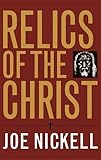Relics of the Christ / Joe Nickell.
Material type: TextPublication details: Lexington : University Press of Kentucky, γ̐ư2007. Publication details: Lexington : University Press of Kentucky, ©2007.Description: 1 online resource (xi, 215 pages) : illustrations, mapContent type:
TextPublication details: Lexington : University Press of Kentucky, γ̐ư2007. Publication details: Lexington : University Press of Kentucky, ©2007.Description: 1 online resource (xi, 215 pages) : illustrations, mapContent type: - 9780813172125
- 0813172128
- 9780813137315
- 0813137314
- 1283327600
- 9781283327602
- 232.96/6 22
- BT465 .N53 2007eb
- online - EBSCO
| Item type | Current library | Call number | URL | Status | Notes | Barcode | |
|---|---|---|---|---|---|---|---|
 eBook
eBook
|
Biblioteca "Angelicum" Pont. Univ. S.Tommaso d'Aquino Nuvola online | online - EBSCO (Browse shelf(Opens below)) | Online access | Not for loan (Accesso limitato) | Accesso per gli utenti autorizzati / Access for authorized users | (ebsco)198469 |
Includes bibliographical references (pages 193-200) and index.
Introduction : the life of Jesus -- The cult of relics -- Christian relics -- The Holy Grail -- Self-portraits of Jesus -- The true Cross -- Other crucifixion relics -- Holy shrouds -- The Shroud of Turin -- 'Photograph' of Christ -- The Sudarium of Oviedo -- Blood of Jesus -- The James ossuary.
Print version record.
The Holy Grail, the Lance of Longinus, and the True Cross are some of the most revered artifacts in the world today. These Christian relics are also a source of limitless controversy. They have incited bloodshed and, some say, are a source of miracles. They inspire fear and hope among the faithful, and yet are a perennial target for skeptics, both Christian and secular. To research the authenticity of numerous Christian relics, Joe Nickell employs a scientific approach, using such techniques as radiocarbon dating, polarized-light microscopy, and forensic serology. Examined here are such significant relics as the Shroud of Turin, the multiple heads of John the Baptist, and the "incorruptible" corpses of saints. For each relic, Nickell examines evidence indicating that the item is legitimate, evidence suggesting that it is not, and whether or not the relic and the miracles attributed to it can be recreated. In addition to his own experiments, Nickell presents findings from the world's top scientists and historians regarding these controversial objects of reverence and ire. But he is ultimately guided by the maxim, "extraordinary claims require extraordinary proof." In treating each relic as a mystery to be solved, Nickell seeks only to find the truth. - Publisher


